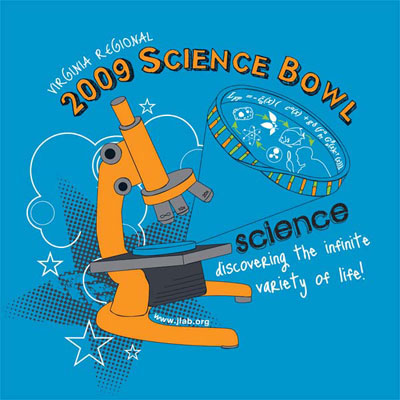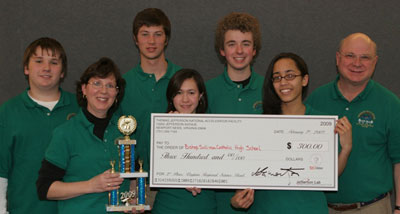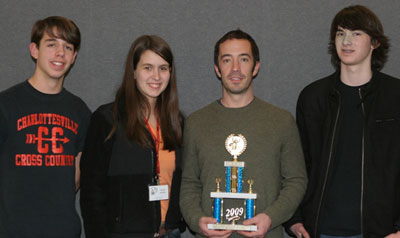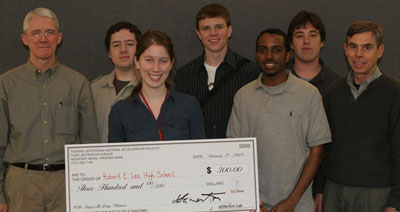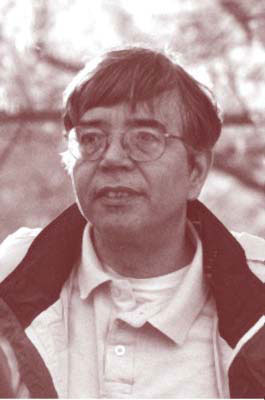
|
February 2009
|
|
|
The U.S. Department of Energy's Thomas Jefferson National Accelerator Facility
|
|
Jefferson Lab Begins Year Awarding Contracts to Start Work on $310-Million Upgrade |
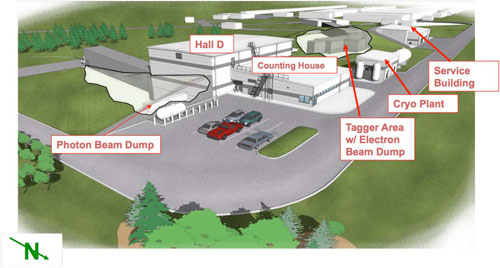 This architectural rendering depicts Jefferson Lab's Hall D complex, to be built as part of a $310-million upgrade to the Continuous Electron Beam Accelerator Facility. The rendering was executed by Hayes, Seay, Mattern & Mattern, Inc., of Roanoke, Va.
Jefferson Lab started 2009 by announcing the awarding of four contracts as part of the $310 million 12 GeV Upgrade Project that will provide physicists with a cutting-edge facility for studying the basic building blocks of the visible universe. A Virginia Beach company was awarded a $14.1 million contract to construct a new experimental hall (Hall D) and supporting facilities that are part of the project. Under the contract, announced Feb. 4, S.B. Ballard Construction Co. will build 20,000 square feet of new facilities. This will include Hall D, an 8,000-square-foot facility that will be Jefferson Lab’s fourth experimental hall; a 250-foot extension of the CEBAF underground accelerator tunnel; and new roads and utilities to support the new experimental hall. Construction is expected to start this spring with completion expected in late summer 2011..... more |
|
|
Safety is Everyone's Business: Report All Injuries & Near Misses
|
JLab Gets High Ratings from DOE; JSA Earns Contract Extension
|
2009 JSA Postdoctoral Research Fellowship Awarded
|
||
|
|
||||
Below the Fold:
|
||||
Jefferson Lab Begins Year Awarding Contracts to Start Work on $310 Million Upgrade |
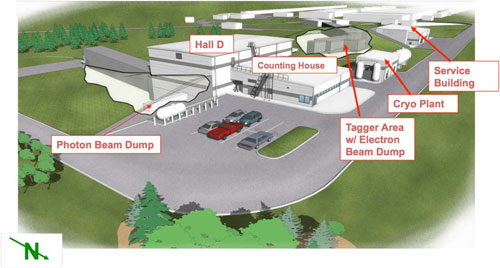 Hall D rendering executed by Hayes, Seay, Mattern & Mattern, Inc., of Roanoke, Va.
Jefferson Lab started 2009 by announcing the awarding of four contracts as part of the $310 million 12 GeV Upgrade Project that will provide physicists with a cutting-edge facility for studying the basic building blocks of the visible universe. A Virginia Beach company was awarded a $14.1 million contract to construct a new experimental hall (Hall D) and supporting facilities that are part of the project. Under the contract, announced Feb. 4, S.B. Ballard Construction Co. will build 20,000 square feet of new facilities. This will include Hall D, an 8,000-square-foot facility that will be Jefferson Lab’s fourth experimental hall; a 250-foot extension of the CEBAF underground accelerator tunnel; and new roads and utilities to support the new experimental hall. Construction is expected to start this spring with completion expected in late summer 2011. In January, the lab awarded a contract worth $1.5 million to Ritchie-Curbow Construction Co. of Newport News for the construction of an addition to the Central Helium Liquefier building. The expanded building will house much of the equipment necessary to double the refrigeration for the upgraded accelerator. Two additional contracts were awarded to vendors from Japan and Germany for materials required for the construction of particle detectors and related electronics for Hall D and the planned Glue Excitations Experiment, also known as Glue-X. A contract worth $3.3 million was awarded to Kuraray Co. of Japan for nearly 2,000 miles of plastic scintillation fibers for a barrel calorimeter which is the largest detector planned for Hall D and the Glue-X experiment. The calorimeter will be 13 feet long, 6 feet in outer diameter and weigh more than 30 tons. It will detect and measure the positions and energies of photons produced in experiments. Its precision will allow physicists to reconstruct the details of individual particle's properties, motion and decay. Precise timing information on charged particles collected by the barrel calorimeter also will allow physicists to identify particles that have gone undetected (i.e. missing energies). The final contract was awarded to Acam-Messelectronic GmbH of Germany, for 1,440 ultra-precise integrated time-to-digital converters needed to read out the signals from particles in the Hall D experiments. The contract is valued at about $200,000. The contracts are the first of the 12 GeV Upgrade Project to be awarded since Jefferson Lab received approval from the Department of Energy in September to start construction – also known as Critical Decision Three, or CD-3. Under the project, funded by the Office of Nuclear Physics within the DOE Office of Science, the lab will double the energy of its accelerated electron beam from 6 billion electron volts (GeV) to 12 GeV and upgrade the equipment in its three existing experimental halls, as well as construct the new Hall D. |
Safety is Everyone's Business: Report All Injuries & Near Misses |
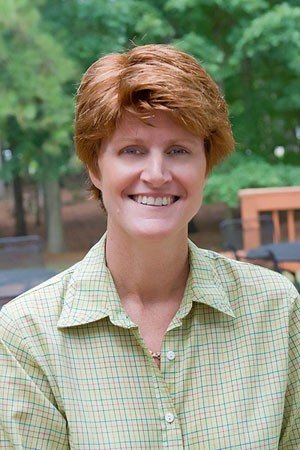 Mary Logue
Environment, Safety, Health & Quality Associate Director Good safety is good business, and safety at Jefferson Lab is everyone's business. Whether you are a physicist, technician, administrator, subcontractor, user or student, you need to maintain a level of safety awareness, train appropriately and work safely on a daily basis. And when an injury or near-miss incident occurs, you must report it. Reporting incidents or mishaps is as important as avoiding them. Last year, there were a few cases where employees didn't report injuries or delayed in reporting them. If injuries aren't promptly and properly diagnosed and treated, they can get worse, which can result in additional pain and recovery time. Improper or delayed reporting can also potentially impact a worker's compensation benefits or lead to a reprimand. It is equally important to report near-miss incidents. We learn from every situation and we post lessons learned on the ESH&Q webpage. We learn as much from a near-miss situation as from a mishap, and with a near-miss report we have the opportunity to prevent a similar or more devastating event from happening at Jefferson Lab or another Department of Energy laboratory. We can save lives, prevent disabling injuries and save potentially lost time and money by effectively investigating and learning from all mishaps and near misses. All injuries are to be reported to your supervisor and Occupational Medicine. Even if you believe the injury to be minor and you’ve treated yourself, either you or your supervisor needs to call Occupational Medicine at ext. 7539. Medical staff will assess whether they need you to come in for further evaluation. If the injury is truly minor, they will note the information in their first aid log and disseminate that information to your supervisor, the division safety officers and a limited number of people in ESH&Q. Near-miss situations should be reported immediately to your supervisor, safety warden or division safety officer, and to Lead Quality & Safety Engineer Stephen Smith, ext. 7007. To prevent similar or even more serious mishaps, safety staff looks at each incident to figure out the cause(s) and how to prevent recurrence. In addition, trends in "minor" events can warn of the potential for more serious events. Our goal is that everyone comes to work on a given day in good shape, does their work, and goes home in that same good shape or better. We need your help in meeting this goal. We need you to tell us where we need to look. Together we make Jefferson Lab a great place to work and a safe place to work. Mary Logue |
JLab Gets High Ratings from DOE; JSA Earns Contract Extension |
|
Jefferson Lab again scored well when the Department of Energy released its 2008 annual performance report cards for the 10 national research laboratories that come under DOE's Office of Science. Jefferson Lab received an "A" for science and technology and an "A-" for management and operations. These high marks and those from the prior two years mean that Jefferson Science Associates' contract to manage and operate Jefferson Lab will be extended for three more years. In a Feb. 5 e-mail to all Jefferson Lab staff and users, Lab Director Hugh Montgomery congratulated everyone affiliated with the lab for an outstanding year. The annual report cards issued by DOE’s Office of Science evaluate the scientific, technological, management and operational performance of the contractors who run its 10 national laboratories. The report cards are based on eight common performance goals that focus on the delivery of science and technology; the operation of the labs in a safe, secure, responsible and cost-effective way; and the leadership, stewardship and value-added provided by the senior leadership of the labs and their managing contractors. A "B+" grade is earned when an "expected" performance level is met. Grades above B+ indicate performance that exceeds expectations. Grades lower than B+ indicate a performance that has not met expectations and needs improvement. On Feb. 5, Jefferson Science Associates posted a news release announcing the contract extension. The release read in part: JSA's contract with the U.S. Department of Energy will be modified after all necessary approvals are obtained. The extension is based on performance scores that Jefferson Lab received over the past three performance periods. DOE's Office of Science released performance scores that showed that Jefferson Lab met or exceeded performance expectations in all areas during the 2008 fiscal year, the period from Oct. 1, 2007 to Sept. 30, 2008. The lab received an "A" for science and technology, and an "A-" for management and operations. "The lab continuously strives to produce world-leading nuclear physics research, to provide a safe and healthy work place, to protect the environment, and to wisely use taxpayer dollars. All of us are pleased that the DOE has recognized our efforts with a contract extension and an outstanding report card. All of us at the lab are proud of the work that we do," said Hugh Montgomery, JSA president and Jefferson Lab director. In 2006, JSA received a five-year operating contract from DOE that provided the ability to earn up to an additional 15 years. With the extension, JSA will continue to operate Jefferson Lab until 2014. JSA was created by Southeastern Universities Research Association and Computer Sciences Corp. specifically to manage and operate Jefferson Lab. "Jefferson Lab is a remarkably productive research center that brings university physicists and other researchers together for collaborative work in a world-class facility. With its extension of the JSA contract, the Department of Energy has acknowledged the Lab's outstanding performance and its role in advancing the nation’s science and technology programs," said University of Virginia President John Casteen, chair of the JSA board of directors. The JSA news release is available at: https://www.jlab.org/news/releases/jefferson-lab%E2%80%99s-good-performance-leads-contract-extension-us-doe The DOE report, titled DOE FY 2008 Performance Evaluation Report of JSA is available at: https://www.jlab.org/intralab/measures/FY08%20DOE%20Performance%20Evaluation%20Report.pdf An explanation of the DOE annual performance appraisal process is available on the DOE webpage at: http://science.energy.gov/lp/laboratory-appraisal-process/ And the FY 2008 report cards for all 10 labs, including Jefferson Lab, are posted on this page: http://science.energy.gov/lp/laboratory-appraisal-process/archives/fy-2008/ |
2009 JSA Postdoctoral Research Fellowship Awarded |
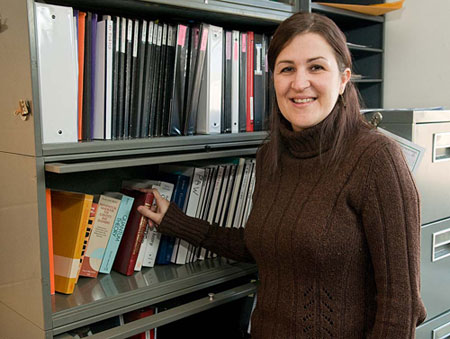
Patricia Solvignon
Argonne National Lab Postdoc 2009 JSA Postdoctoral Research Fellowship Recipient The Jefferson Lab Users Group Board of Directors selected Patricia Solvignon as the winner of the 2009 JSA Postdoctoral Research Fellowship. Solvignon is a postdoctoral appointee at Argonne National Lab. Fellowship applicants were judged on their records of accomplishment in physics, proposed uses of the research grant in a high-impact physics program and the likelihood of further accomplishments in the Jefferson Lab research fields. "It is a pleasure that we have many excellent postdocs working on Jefferson Lab physics, even though it makes our job of evaluating them difficult," said Ron Gilman, board chairman and a professor at Rutgers University. "They were all very good, so it was hard work for us to select a single, best individual." JSA President and Jefferson Lab Director Hugh Montgomery congratulated the winner, adding, "Patricia is a worthy recipient and an outstanding young physicist. The grant continues our commitment to providing the next generation of scientists with challenging and rewarding research opportunities, which ultimately benefits all of society." Although Solvignon represents postdoctoral researcher interests on the board, she was not privy to fellowship deliberations. "It was a big surprise, and I was very happy to get it. I'm fortunate that I work with people who are very supportive, and in particular, John Arrington, my supervisor," she said. "I'm honored to receive the fellowship." Solvignon has a broad range of interests. For example, she is lead author on a recent publication concerning the spin of the neutron, and she continues to work in this field. She is also investigating how the distributions of quarks in protons and neutrons (nucleons) are changed when the nucleon is put into a nucleus, through what is called the EMC effect, named after the collaboration to first discover it. In addition, Solvignon studies how correlations between nucleons within a nucleus lead to these nucleons having high momentum, several times as much as one would expect if there were no correlations. "We are looking at how the nuclear force is working between protons and neutrons inside the nucleus," she explained. It is this last experiment that will benefit in particular from the $10,000 fellowship research grant. The grant will go toward the purchase of a stainless steel vacuum glove box for handling calcium-48. Planned for use as a target material in the experiment, this rare calcium isotope oxidizes when exposed to air. "To prepare it for the experiment, we need to put it into a vacuum glove box that is very good at keeping oxygen out. We can not do the experiment without the box," Solvignon said. Due to its rarity, calcium-48 is expensive, at about $150,000 per gram. By purchasing and using the specialized box, she and her colleagues can borrow a sample of calcium-48 and return it after the experiment is completed, saving more than $100,000 in costs for the experiment. "Jefferson Lab will not have to pay as much at this difficult budgetary time," Solvignon added. Approved at the 2008 meeting of the Program Advisory Committee, PAC 33, the experiment is scheduled to run in 2011 in Hall A. One part of the experiment is aimed at revealing how the intrinsic spin of nucleons and their constituents plays a role in short-range correlations. "What we want to look at is the isospin dependence of short-range correlations," Solvignon said. In previous experiments, additional nuclear effects clouded measurements of this particular property. Solvignon and her colleagues hope to get a better measurement by comparing the results they get using calcium-48 versus another isotope of calcium to be used in the experiment, calcium-40. "A lot of these effects cancel in the ratio, so we should have a cleaner measurement," Solvignon explained. In addition, calcium-48 contains more neutrons in its nucleus than more common isotopes of calcium. "With more neutrons, you should get more reactions." The goal is a better understanding of the different interactions that take place between proton-proton, neutron-neutron, and proton-neutron pairs in the nucleus. The JSA Postdoctoral Research Fellowship was initiated by the Users Group Board of Directors. The research grant is provided by Jefferson Science Associates, LLC, through the JSA Initiatives Fund. By Kandice Carter |
Procurement Department: Bringing 12 GeV Upgrade to Life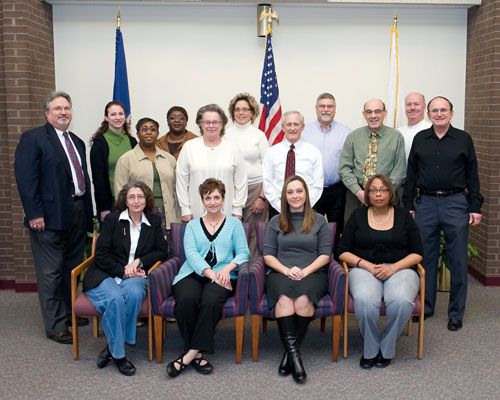 Procurement Department includes, back row, left to right: Chief Financial Officer and Business Operations Manager Joseph Scarcello, Erin Smith, Denise Leary, Katrina Sample, Teresa Danforth, Melissa Torres, Ross Small, Mitchell Laney, Procurement Director Mark Waite, Albert DeChristopher and Danny Lloyd, and front row, l. to r.: Dena Polyhronakis, Barbara Rice, Sharon Williams and Renee Carter.
Making a $310-million project move from the drawing board to a construction zone sounds simple, but doing so requires a lot of hard work and planning. Since 2004 when the 12 GeV Upgrade received Critical Decision Zero from the Department of Energy, Jefferson Lab's Procurement Department has been actively involved. The department's initial challenge, according to Procurement Director Mark Waite, was to help formulate an acquisition strategy document that would provide the framework for all subsequent procurement activity supporting the 12 GeV Project. The success of this effort was achieved through a close working relationship and teamwork between Procurement, 12 GeV Project Management and the Department of Energy, Waite added. A second challenge was to ensure that the Procurement Department's centrally managed resources were optimized and aligned to meet the short- and long-term needs of the upgrade project. Key to that task was the available nucleus of high-quality, experienced procurement professionals in the Procurement Department, who had provided contracting support for JLab's Continuous Electron Beam Accelerator Facility and the Oak Ridge National Lab's Spallation Neutron Source projects, and who had expertise in managing highly complex multi-year acquisitions. Procurement's support to 12 GeV was aligned around three key functional areas: major commodities and systems subcontracts, led by Ross Small; construction and services subcontracts, led by Teresa Danforth; and commercial purchases and fabrications, led by Danny Lloyd. JLab's procurement scheme was fundamentally different from most of its larger, DOE, sister-laboratories' projects "because we used our existing, centralized procurement activity to support the upgrade project rather than a decentralized activity. Often-times laboratories set up a separate and decentralized, project-dedicated procurement shop solely to support specific projects," Waite explained. Although both approaches work, JLab's strategy has proven to be very cost effective and provides procurement with the flexibility needed to support non-12 GeV Upgrade requirements, Waite said. Currently, procurement management and staff are busy working with the 12 GeV control account managers to process and plan for fiscal year 2009-2012 requirements. Major accomplishments to date include the development and approval of 31 Advanced Procurement Plans; the awarding of approximately $21 million in contracts that include the architectural and engineering services, construction contracts for the civil portion of the Hall D Complex and the Central Helium Liquefier building addition, integrated time-to-digital signal converters for Hall D, and scintillation fibers for Hall D's barrel calorimeter. In addition, procurement is currently processing seven major acquisitions, which include quadrupole magnet assemblies, 4-meter XP dipoles, klystrons, cavities, a Torus magnet, a 4.5 Kelvin cold box and Q1 quadrupole magnets all for award in FY2009. "Procurement is working to fill additional authorized critical positions to further enable Ross' major commodities and systems subcontracts group to process and administer incoming requirements to the department currently and increased requirements anticipated over the next several years," Waite said. "Getting the necessary depth of experience has been challenging as we are often in direct competition for contract specialists with other organizations in this area," he added. "However, we have been fortunate to recently hire a senior subcontracting professional, Judy Marcello, who joined the department in February." Procurement plans to hire one additional senior subcontracts position and monitor the overall workload needs for FY2010. When asked about the Procurement Department's support to JLab, Joe Scarcello, chief financial officer and business operations manager, said, "I am very pleased with the procurement staff’s dedication and hard work. The cooperation between Mark’s organization, lab customers, the upgrade project team, and the Site Office, particularly in their advanced procurement planning, has been great. These elements together are basic to the successful support provided thus far and for future support." In Their Own Words With JLab's Cyber Security Analyst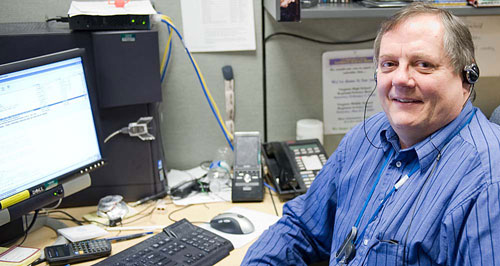 Greg Nowicki
Security Analyst Information Technology Division I was born in St. Paul, raised in Minneapolis, and, believe me, I don't miss the weather at all. The last winter I was up there, we had more than 100 inches of snow! I originally thought I would pursue a career in geology, but my attention turned to computer science. I'd actually spent years working on automobiles – I've always loved taking things apart – before moving to Hampton Roads with my wife, Loree, who's an accountant, to be closer to her family in Poquoson. By 1990, I'd finished my degree in computer science at Christopher Newport University and was working at NASA-Langley Research Center in computer support, designing, building and testing instruments for real-time atmospheric data. It was interesting work, but involved a great deal of travel. Our children – Daniel and Genevieve – were young and I hated being away from them so much. In 1997, we moved to Oregon, where I worked as a system, security and network specialist for six years. We returned to Hampton Roads in 2002 when I returned to NASA, this time working as an atmospheric scientist. As luck would have it, I met David Bianco who was a cybersecurity analyst at Jefferson Lab at the time. He told me a position was coming open and I jumped at the chance to work here. I came to the lab in 2005, and now that David has left, you might say that I am the face of computer security. Our security concerns shift continuously. We are seeing more organized groups who might attempt to breach our security for a variety of reasons (financial, business sensitive, phishing, etc.) and it's our job to stay one step ahead of them. Much of our work involves monitoring traffic over the network, to do signature-based detection, and to trace down whether or not any intrusions are malicious. Our job is not to make anyone's job here more difficult; it's to facilitate what our users (computer account holders) need, all with the goal of adhering to Department of Energy policies and to make the accelerator and the science that we do here run perfectly. We're always willing and happy to work with individuals to help them get what they need. If there's no good science going on, there's no need for us to be here. Our attitude is "Let’s find a solution and fulfill the lab's cybersecurity requirements." I am busy here and at home, too. I still work on cars and maintain a network in my home, where we have a computer in every room. One of my oldest and most cherished possessions is a 1974 Triumph Trident T150V motorcycle, but I don’t ride it much because the maintenance time on that beauty is about one hour of tinkering for every one hour of riding. When we lived in the Portland, Ore., area I fell in love with micro-brewed beers and brew several kinds throughout the year, mostly Belgian style, five gallons at a time. My family belongs to Resurrection Lutheran Church, where I help out with audio-visual and computer support, so I’m often working with computers whether I’m at the lab or not. As told to Judi Tull Use USB 'Flash' Drives With CareUSB drives are popular for storing and transporting data, but some of the characteristics that make them convenient also introduce security risks. These risks include USB drives that have been infected with viruses, Trojans or other malware either at the factory or later. These devices can infect your computer and assist in the spread of that infection to other computers. Additionally, USB drives allow for easy theft of data from a computer. It can be quickly plugged in and have sensitive data written onto it. Probably the greatest risk is the loss of the media. Aside from the loss of important data, if this device falls into the wrong hands, irreparable damage can be done. To protect yourself, your system and your data, always backup the data contained on a USB drive. Don't use it for carrying sensitive data or mix personal and business data. Keep your anti-virus software/utility up-to-date. It will scan your USB drive when it is inserted into your computer and check for viruses. And, if possible, encrypt the data on the drive. JLab has taken steps to disable the capability of the lab's computers to automatically run a CD or USB drive when it's been inserted into your computer. Even so, media of unknown origin, found or "gift" USBs should not be inserted in your machine. Don't use USB drives that have come to you from unknown or unexpected sources. More information is available at: http://www.us-cert.gov/cas/tips/ST08-001.html. By Greg Nowicki Outgoing NSAC Chair Discusses Future of Nuclear PhysicsEditor's note: Following a colloquium at Jefferson Lab in February, Texas A&M University Physicist Robert Tribble chatted with JLab Science Writer Kandice Carter about the field of nuclear physics and its future. It’s been a busy three years since Robert Tribble, a professor of physics at Texas A&M University, took over as chairman of the Nuclear Science Advisory Committee. NSAC is an advisory committee that provides advice to the Department of Energy and the National Science Foundation on the national program for basic nuclear science research. During Tribble’s tenure, the committee has addressed several issues through the work of various subcommittees, such as a review of U.S. neutrino oscillation experiments and recommendations on facilities for rare isotope beams. But by far the largest project completed by the committee was the development of "The Frontiers of Nuclear Science: A Long-Range Plan" in 2007. The document lays out the top priorities for nuclear physics and is the result of a year-long process that culminates in the committee making tough decisions on where the field should focus its resources to ensure a vibrant future. Tribble explained how the committee goes about preparing a plan. "It’s really a community-driven activity. When we get a request for putting together a new long-range plan, the very first thing we do is go to the American Physical Society's Division of Nuclear Physics and discuss with them how they can put together town meetings, where people can sit down together and prioritize what they think is important," Tribble said. White papers are generated from those town meetings and additional input is sought from researchers whose work wasn’t already represented and from those abroad to give the committee a better sense of the field's priorities. 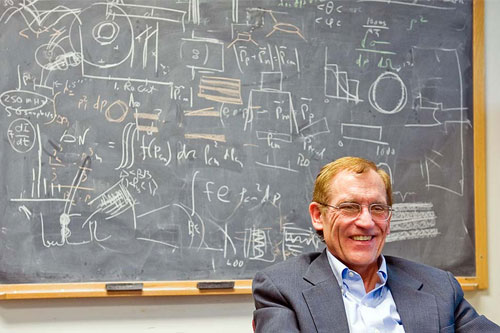 Robert Tribble
Professor of Physics, Texas A&M University and NSAC Chairman "So with all of that information, then you have to start making some lists as to what the major projects are, and what the major focus of particular parts of our field should be, and that's where having the experts in the field get together gives you the best chance of doing something reasonable," Tribble added. All that hard work led to a document that defines the overarching scientific questions being pursued, outlines recent accomplishments, and makes recommendations on the facilities needed for world-leading research. It also addresses special initiatives and the resources needed to continue the pursuit of answers for nuclear physics' most pressing questions. "We have put down what we want to do for the next decade. If we are able to accomplish that, we'll have an absolutely first-rate program in QCD based at JLab and at RHIC. We will have a new initiative going forward with fundamental symmetries with very, very important experiments taking place and facilities such as the deep underground science lab. And we will have a major new facility just about to come on for low-energy nuclear physics," Tribble said. "The combination of all of those would give us an extremely bright future for really learning a lot over the next several decades." Tribble is now working with a subcommittee on producing a long-range plan for isotope production. "We've had several interruptions in isotope production that have caused severe problems for the medical community recently," Tribble explained. The subcommittee is still gathering information and expects to produce recommendations by late summer. In the meantime, Tribble is looking forward to the next NSAC meeting on March 2, where he will hand the gavel over to incoming chairperson Susan Seestrom of Los Alamos National Lab. "The last three years on NSAC have been very busy, but I think that they have also been a very interesting learning experience for me. And I think that anyone who gets the opportunity to do that should take it," he noted. He said he plans to refocus on his own research and that carried out at Texas A&M's Cyclotron Institute, where he serves as director. When asked about his most notable accomplishment, Tribble points to the long-range plan. "I think we did a creditable job in completing the long-range plan. So I think that's what I would have to put for the number one thing I’ve accomplished as chair of NSAC." By Kandice Carter 'Science of Art Conservation' Discussed at March 10 LectureLearn how the care and conservation of a work of art helps people better understand and appreciate its meaning by attending a public Spring Science Series lecture to be held Tuesday, March 10 at Jefferson Lab. Scott Howe, director of education and public programs from the Chrysler Museum of Art in Norfolk, will discuss the science of art conservation from 7-8 p.m. at JLab's CEBAF Center auditorium. Howe will discuss the painting "Madonna and Child" by Jan Gossaert. He will address the meaning of the painting, its physical changes over time, and efforts to learn more about the painting through conservator's tools, such as microscopes, X-ray, ultraviolet light and infrared imaging. The result will be an entirely new understanding of this 16th-century masterpiece – an understanding that wouldn't be possible without an array of scientific tools. Howe's discussion of the painting will provide the audience with an interesting mix of theology, science and history. It is open free of charge to anyone interested in learning more about science. The program will last about one hour and include a question-and-answer period at the end. Jefferson Lab is located at 12000 Jefferson Ave., Newport News. For security purposes, enter at JLab's main entrance (Onnes Drive.). Everyone over 16 is asked to carry a valid photo ID. Security guards may perform ID, parcel and vehicle checks. For directions and information about other Jefferson Lab public lectures, visit http://education.jlab.org/scienceseries/index.php, or contact Christine Wheeler, Science Education, at wheelerc@jlab.org or call 757-269-7560 Middle School Science Bowl to Bring 23 Teams to JLabThe nation's future scientists, engineers and mathematicians may be found testing their mental skills at the Virginia Regional Middle School Science Bowl taking place at Jefferson Lab on Saturday, March 7. Twenty-three teams, representing middle schools from across the state are registered for this year's academic competition. The National Science Bowl tournament – sponsored by the Department of Energy – is an annual, academic competition among teams of students. The teams face off in an intense question-and-answer format where contestants are quizzed on their knowledge of math and general science. "This is a fun, exciting event for middle-schoolers that encourages and nurtures their interest in learning more about math, science and technology," notes Jan Tyler, Jefferson Lab's Science Education manager and the planner for this event. "We are delighted with the number of teams registered this year. This is our fifth year hosting the event. And interest and participation has grown every year. Many schools that have competed in the past will be returning with multiple teams; and several schools will be participating for the first time." The top three teams from this event will earn cash prizes for their respective schools. The top team also wins an expenses-paid trip to the Middle School Science Bowl Nationals to be held near Washington, D.C., April 30 through May 5. The public is invited to attend the semifinal and final rounds of the March 7 competition at Jefferson Lab, which will run from 1:30-5 p.m. in Jefferson Lab's CEBAF Center auditorium located at 12000 Jefferson Ave., Newport News. For security purposes, visitors must enter at Jefferson Lab's main entrance (Onnes Dr.). Everyone 16 and older is asked to carry a valid photo I.D. Security guards may perform parcel and vehicle inspections.
Volunteers Needed to Help With March 7 Science BowlMore than 70 volunteers will be needed to run the Science Bowl. Most of the volunteers needed will perform as competition moderators, rules judges, timekeepers and scorekeepers during the morning, round-robin sessions, according to Tyler. She will also need a smaller number of volunteers to run the afternoon double-elimination matches, be the on-site scientific judge who is called when a student challenges a question or answer during the competition, and a few individuals to help with administrative tasks. Volunteers may sign up for the morning shift (9 a.m. to 1 p.m.) or the day (9 a.m. to 3 p.m.). "The Middle School Science Bowl isn't as intense as the high school event," Tyler adds. "This is a great event for someone who wants to help for the first time or if they'd like to try out a new task." A practice session for volunteers to familiarize themselves with their responsibilities will be held Thursday, March 5, at 2 p.m. in CEBAF Center room F113. Volunteers receive a Science Bowl T-shirt; and volunteers helping all day get a sandwich lunch. For more information, contact Tyler via email at tyler@jlab.org. High School Science Bowl Was Great Success: Alexandria Team Takes First at Event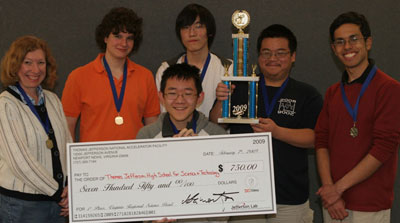
The Thomas Jefferson High School for Science and Technology team from Alexandria poses with its first-place trophy after the competition. Pictured from left are Coach Sharon Webb, Greyson Lewis, Hanwen Xu (front), Kee Young Lee, Daniel Li and Aaron Koenig. Photo: Steve Gagnon
The Thomas Jefferson High School for Science and Technology from Alexandria beat out Princess Anne High School of Virginia Beach, 76-26, in the final round on Feb. 7 to win the Virginia Regional High School Science Bowl held at Jefferson Lab. Princess Anne finished in second at the end of the intense, day-long academic competition, while Bishop Sullivan Catholic High School, also from Virginia Beach, finished third. Charlottesville High School, Charlottesville, took fourth place. The TJHSST team, coached by Sharon Webb, won an expense-paid trip to the Department of Energy Science Bowl Nationals to be held near Washington, D.C., April 30 to May 5. The team also took home a $750 check for its school, the regional banner that the team will carry to nationals, a team trophy and individual medals. The Princess Anne team, coached by Mary Jane Meyer and Clare Kerr, received a $500 check for its school and a team trophy. The Bishop Sullivan team, coached by William Dunn and Carol Stapanowich, earned a $300 check for its school and a team trophy. And the Charlottesville team, coached by Matt Shields, took home the fourth-place team trophy. 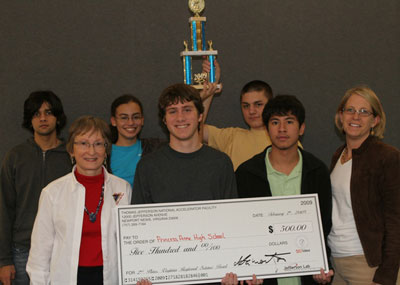
The Princess Anne team from Virginia Beach poses with its second-place trophy. Pictured is (back row, left to right) Sunny Gautam, Rachel Downing and Jan Hartmann, and (front, l. to r.) Coach Mary Jane Meyer, Ryan Cousins, James Castor DelosReyes and Coach Clare Kerr. Photo: Steve Gagnon
Twenty-one teams, representing high schools from across the commonwealth competed in this year's academic competition. The National Science Bowl tournament – sponsored by the DOE since 1991 – is an annual competition among teams of students. The teams face off in an intense question-and-answer format where contestants are quizzed on their knowledge in all science disciplines, including astronomy, biology, chemistry, earth science, general science, mathematics and physics. The day is broken into two rounds: morning round-robin matches, followed by double-elimination matches in the afternoon. A match is two eight-minute halves with a two-minute break. Teams that didn't advance to the afternoon round were invited to compete in a design and engineering challenge dubbed the Stay All Day Contest. Teams were presented with three very different activities where they had to analyze problems, develop working prototypes with specific materials and make projections based on a model's performance. The team with the best combined results for the activities was Robert E. Lee High School from Springfield and coached by Gregory Matthes and Rick Priest. "These events champion an interest in science, math and engineering among our nation's youth," notes Jan Tyler, JLab's Science Education manager. Milestones: December 2008 - February 2009Hello Phillip Childress, Construction Safety Representative, Facilities & Logistics Management, Chief Operating Officer Division Goodbye Dianne Greene, Eurest/Quark Cafe grill cook Congratulations Congratulations to Bob Doane, with the Quality Assurance/Continuous Improvement Department of the Environment, Safety, Health & Quality Division. He passed the American Society for Quality, Certified Quality Engineer exam on Dec. 6. These Milestone entries, listed alphabetically, are actions posted by Human Resources during December 2008 through February 2009. For more information about employment at JLab, visit: http://www.jlab.org/div_dept/admin/HR/employment/index.html. JLab Mourns Loss of Physicist Mike Finn
John Michael Finn, 63, a College of William and Mary physics department professor and Jefferson Lab user, passed away Jan. 31 due to a heart attack, according to the Feb. 1 Williamsburg-Yorktown Daily. Known by many as Mike, Finn was an avid and passionate poet and served as the York/Poquoson Democratic Committee chair. At JLab he most recently served as one of the Q-weak Experiment's collaboration spokespersons. Finn had been on the faculty of the W&M since 1985 arriving after receiving his Ph.D. in 1975 from Catholic University, and after postdoctoral positions at the University of Massachusetts, Amherst, and Louisiana State University. While a physics graduate student, he was drafted into the U.S Army. He served for two years as an infantryman with the Forth Infantry Division, stationed in the Central Highlands of Vietnam, where he was awarded two U.S. Army Commendation Medals for meritorious service. Over the years at W&M, Finn taught a wide variety of courses in the physics department, ranging from introductory undergraduate physics to graduate level courses. He supervised the dissertation research of eight Ph.D. students, and recently published a graduate-level textbook, "Classical Mechanics", Infinity Science Press. His research was in experimental nuclear physics, conducted mainly in recent years at Jefferson Lab, and previously at the MIT/Bates Lab, Los Alamos National Lab, CEA-Saclay (France) and the Naval Research Lab. He was a leader and co-spokesperson for two major experiments at Jefferson Lab, the HAPPEx experiment, a pioneering measurement which searched for strange quark effects in the proton, and Q-weak, which will test the Standard Model of particle physics. He was an author of over 90 scholarly papers on nuclear physics, as well as numerous presentations at national and international physics conferences. His service to W&M College governance included membership in the Educational Policy committee and the Committee on Graduate Studies, and several physics department committees. In addition to his academic publications in physics, he published two books of poetry, "Flashback: A Journey in Time" and "Butterfly Girl", both published by 1st Book Library, as well as "Ghost Tracks", a memoir of the Vietnam War, published by Royal Fireworks Press. He was also politically active, most recently serving as the chair of the York/Poquoson Democratic Party committee. The Funeral and Mass were on Feb. 9 at St. Olaf's Catholic Church in Norge, Va. Finn leaves behind a wife, Kit, five children and two grandchildren. The Finn Family asks that in lieu of flowers, contributions be made to an education fund for his younger children and grandchildren that can be sent to 133 Little John Rd., Williamsburg, VA 23185. Finn, a self-described "physicist by training and a poet by accident," was known by many for his energy, passion and insight. He was teaching a course at W&M this semester. |
|||
|
The On Target newsletter is published monthly by the Thomas Jefferson National Accelerator Facility (Jefferson Lab), a nuclear physics research laboratory in Newport News, Virginia, operated by Jefferson Science Associates, LLC, for the U.S. Department of Energy's Office of Science. Possible news items and ideas for future stories may be emailed to jlabinfo@jlab.org, or sent to the Jefferson Lab Public Affairs Office, Suite 15, 12000 Jefferson Avenue, Newport News, VA 23606
|


 Good safety is good business, and safety at Jefferson Lab is everyone's business. Whether you are a physicist, technician, administrator, subcontractor, user or student, you need to maintain a level of safety awareness, train appropriately and work safely on a daily basis. And when an injury or near-miss incident occurs, you must report it....
Good safety is good business, and safety at Jefferson Lab is everyone's business. Whether you are a physicist, technician, administrator, subcontractor, user or student, you need to maintain a level of safety awareness, train appropriately and work safely on a daily basis. And when an injury or near-miss incident occurs, you must report it.... Jefferson Lab again scored well when the Department of Energy released its 2008 annual performance report cards for the 10 national research laboratories that come under DOE's Office of Science..........
Jefferson Lab again scored well when the Department of Energy released its 2008 annual performance report cards for the 10 national research laboratories that come under DOE's Office of Science.......... The Jefferson Lab Users Group Board of Directors selected Patricia Solvignon as the winner of the 2009 JSA Postdoctoral Research Fellowship. Solvignon is a postdoctoral appointee at Argonne National Lab.....
The Jefferson Lab Users Group Board of Directors selected Patricia Solvignon as the winner of the 2009 JSA Postdoctoral Research Fellowship. Solvignon is a postdoctoral appointee at Argonne National Lab.....